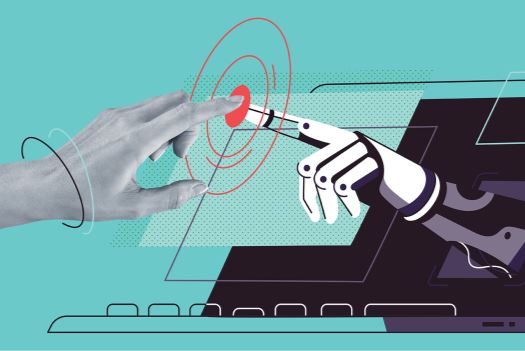Article
4 Questions About AI Answered by Branding Experts


This year, artificial intelligence has dominated headlines and captured the public’s imagination with its brand-new capabilities to generate content through tools like ChatGPT 4 and DALL-E 2. Because of AI’s potentially monumental impact on nearly every industry, many businesses are wondering how to navigate a post-AI world, and how they can best utilize these tools in their branding and marketing efforts.
In this article we’ll break down the current landscape of AI, what it means for the modern labor market, and how it might be useful for brands. Plus, we’ll talk about some of the pitfalls of AI’s current state and some of the limitations with using current AI tools.
What do we mean by artificial intelligence?
AI is the hottest topic out there right now, but its exact meaning has changed over time. Originally, it meant the implementation of clever sub-routines that were able to process the data in new and clever ways. But what it's come to mean lately is training systems on large volumes of data and then creating responses based on the data that's been consumed.
Two main factors have enabled this advancement in the technology behind artificial intelligence. First, the volume of data available to parse has significantly increased over the past several years. Second, the processing power to parse through that vast amount of data has made it possible to train these models with more capability than ever before.
These two factors have enabled large language learning models, like ChatGPT, to consume gargantuan amounts of information and use it to inform the most likely response to a question or command. Though not perfect, these models have generated a significant amount of buzz for their ability to make more specific and advanced content.
The new buzz has also driven up momentum from different organizations that are offering tools that use these AI models to enhance their own product offerings. Companies like HubSpot and Snapchat have introduced AI chatbots into their products, leading to even more buzz about AI’s capabilities and potential uses.
How is AI relevant to brands?
Because of the myriad of tools becoming commercially available to teams in every industry, AI will impact different disciplines in different ways within each industry. Depending on the exact products and services you provide, the use case for AI might look vastly different.
For web and software developers, one example of a helpful tool might be something like GitHub Copilot, which provides recommendations and auto-complete functions while writing code. In fact, earlier this year GitHub announced that Copilot’s code recommendations were being accepted more than 35% of the time. That utility translates to some significantly increased efficiency over time.
For others in the marketing and brand strategy world, helpful AI might look like tools that automate market research. Whether it's through voice of the customer interviews to help analyze interview data, or identifying trends among audiences to shape messaging around, AI tools open up new opportunities to streamline marketing processes.
The major use cases for AI among brands at this point are ways to save time. Based on what you prompt it with and based on what it can see, these tools can feed your team more options faster. You can then analyze the options for yourself to get to the next conclusion quicker, and then move on to the next step.
Will AI disrupt the job market?
As the use of AI proliferates in nearly every industry, many are quick to ask how this might disrupt their career, especially if their role involves writing, designing or other creative pursuits.
But, as with all technological advancements, the people most likely to be successful in this new era of AI tools and technologies are the people who can understand how to use it. Knowing how to make the most of these tools and understanding where they fall short will prove to be an invaluable skill, and make people a more valuable candidate in the job market.
It’s important to recognize that, while there have been great strides in the capabilities of AI, current tools are not exactly able to think of wholly original ideas. In other words, because these tools are consuming large amounts of existing content out there, they are able to piece together usable composite ideas made of existing information. You, the user, are able to add that originality and sift through the most usable parts.
So, in short, human creativity has not become obsolete (yet). If ChatGPT comes up with 30 ideas, only ten may be usable, and out of those options only one or two (or maybe sometimes none of them) may be the right fit for what you’re looking for. The skill of navigating those ideas, coming up with more productive prompts for AI tools and enhancing them with creative originality is one that will become more valuable going forward.
Instead of thinking of AI as a replacement for a human brain, utilize it like an ultra-fast extension of your own brain. It can iterate upon ideas much quicker than humans are able to, and throw out ideas that might spark inspiration of your own. Using it as such will allow you to stay ahead of the curve during the current wave of AI technological advancement.
What are the limitations of AI?
As we touched on above, AI can’t do everything. It’ll require responsible users to check the accuracy and quality of the content it produces, and most of the time it will require us to significantly edit it to cater it to our needs. There are also a few major pitfalls to look out for that AI could end up bringing to your doorstep.
For one, many AI tools may raise a few issues with intellectual property. Tools like DALL-E that take from existing content to create artwork could infringe on copyrighted material, and that is something you’ll have to look out for when using it to create new graphics. You may also have to think about how to protect your own brand from others using such tools, and ensure that your own team is using these tools in a way that remains true to your brand.
With this new dawn of generative AI, the people who get a handle on these tools first will probably be in the best position to succeed, but being nimble and adaptable to all the new technologies, best practices and regulations that come out in response to the increase in capabilities will be just as important.
The more that AI is used by bad actors to, for instance, imitate a brand or disparage a company, the more challenges will arise in regards to protecting a brand’s image. As individual consumers, the necessity for critical thinking is going to go up as the quality of the fakes go up. We're going to have to all get better at questioning the things that we see.
In some ways, the increase in AI capabilities might force us to think backwards from the "imagine, research, write" process. Instead, it's going to be a "write, reimagine, research" kind of thing. It's a real change in the way that people do work, and brands are going to have to think about that. They're going to have to think about the training people need. How do we take that message and flip it back to well-researched information provided?
All in all, more development in the AI world will simply translate into more that we need to learn to keep up with how it’s shifting the landscape of the branding world. As standards and practices change over time, the most agile and willing to learn will be the best equipped for the future.
A Few More Insights
BrandExtract helps businesses inspire belief by aligning their corporate and brand strategies. If you’re looking for help navigating your brand through a major change, don’t hesitate to reach out. Or, explore some of our other insights:







